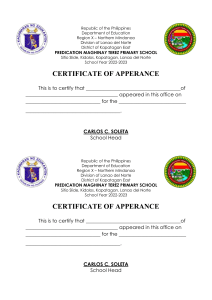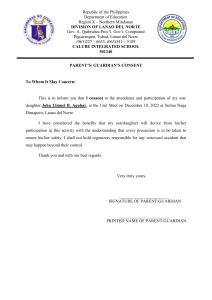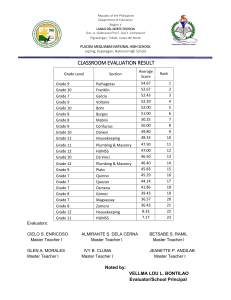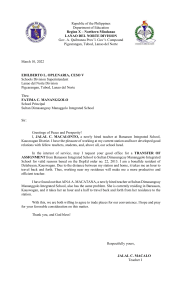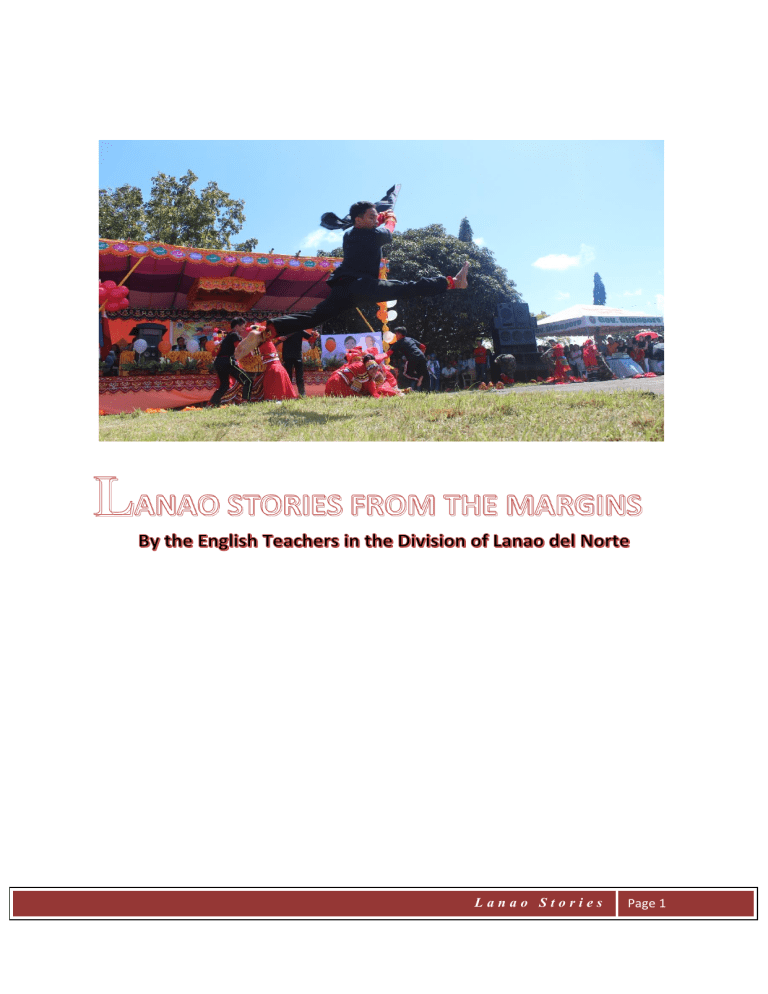
LANAO STORIES FROM THE MARGINS Lanao Stories Page 1 Division of Lanao del Norte December 2018 The Hidden Falls Ritchel S. Rodriguez Robocon E/S, Linamon District Beneath the deep forest, a majestic beauty there lays hidden over the years. It is a sight to behold, not only by me, but to everyone that could encounter such a magnificent sight. Everyone thinks this is a haven of weary souls desiring for much needed escape -- escape to the busy city which most people belong. From highland down to the hidden place, one must walk for almost four hundred steps, , if I am right with my counting, from the first step at the foot of the trail down to the unseen place which is the hidden falls, the Tinago falls. Going down by foot, I can feel my adrenaline rose – ready to go to the hidden place as fast as I could. It was tiresome but was worth the effort. Every sweat that rolled over my forehead and that made my shirt wet was just a very minute sacrifice for the awesome creation my eyes feasted on. As I set my foot on the last step, my jaw dropped jaw with what I saw. I turned around and turned my head 360° degrees. Can you imagine that 360° degreeturn? It was such an excellent masterpiece that our Almighty God had made. Everyone around me exclaimed “Wow”! What a beauty! It was the first time I laid my eyes with such a beauty. Through research, I learned that Tinago falls is approximately 245 feet high. It was an ice-cold water that cascades gorgeously and creating a soft blanket of mist into the serene bluish- green lagoon about a hundred feet deep (it is according to some locals). Beneath the deep water fishes swam rapidly, so one can see the very refreshing and welcoming water waving as if telling any visitor to swim. As a first timer, I was really amazed at the lights in front of me that I immediately get my mobile phone to have a selfie. Click! Click! Pose! Pose! Pose! Though I am not a good swimmer, and I barely swim, this extraordinary place makes me very eager to swim. I was really captivated. The deep blue water was very inviting. But before you can swim in this clear water, one needs to wear a life vest. I swam just very near the big rocks so I have something to hold in case things comes to worse. Then suddenly I heard my name being called by my friends. They were on a big raft. They will go near the cave, near the waterfalls. I was really fascinated. Riding a raft? Such was a first time indeed. So, I hurriedly walked, yet very careful not to slip my feet in the very slippery raft. It was a ride of my life. I was very excited but at the same time scared. This made me ask myself, “What if I fell from the raft? What would happen to me?” It was a thought that Lanao Stories Page 2 came to my mind, but I conquered my fear! I screamed ‘til my lungs were out, as we went nearer the falls. The water splashed as we went nearer. Water from the falls slightly soaked us with its thin showers, It was indeed magnificent that I could hardly explain what I felt. As the water softened my wet clothes, it seemed luring me to dip myself in the cool clean water! As I got nearer the flowing falls, my heart pounded more and more with excitement. Touching the waters with my bare hands and feeling the cold waters as it tickled my fingers, I told myself God made nature so awesome – I am very grateful. 1972 By: Wilma S. Samporna LNNCHS, Baroy, Lanao del Norte It was barely a month after classes opened. Together with my previous classmates, I had just started to enjoy my being a Grade II pupil at Baroy Central Elementary School when bizarre things started to take place usually along the national highway where we lived in a rented house owned by Nang Angela Gonzales – Tatay, Nanay, Junior, Esing and myself, the eldest. At that time, I did not really understand why strange-looking men with long slender guns would march from the direction of Tubod going to the direction of Lala or vice versa. While marching, they would chant lines I did not also understand. They would usually come at dawn or late afternoons. I did not also understand why we, including our neighbors, would close our windows and doors and hide inside the house as soon as we hear them from afar. Through some slits in the wall, we watched them pass by. In my mind, they must be bad guys because why were we hiding from them, in the first place? In my mind, they were ready to kill us because why would they carry guns, in the first place? “Who are they, Nanay? I could not stand the puzzle any longer. “Baracuda”, Nanay answered in a whisper. “Why are they called Baracuda? Are they going to kill us? I asked again. There was silence. She did not answer me anymore. Perhaps she was not also sure of her answer, or she was afraid somebody might hear her reply. I sought Tatay’s mind about the Baracuda and he said, “They are human beings who opted to become enemies of the country.” In my mind, I asked a number of questions including the reasons why some people would love to create trouble. “Why would they not allow others to enjoy a peaceful life?” I nagged myself. Before dinner time, my brother Junior and I developed the habit of going to my Aunt Nanay Mameng’s big store, just two blocks away from our house, because people would gather there to buy things they needed at home like rice and corn grits by the ganta, canned goods, “ginamos” (salted anchovies) and dried fish, bread, soft drinks, liquors, slippers, etc. Others went there to while away time by playing music from the Jukebox that released Victor Wood’s “You Are My Destiny” or Eddie Perigrina’s “What Am I Living For?”. Lanao Stories Page 3 There in the store, haggard-looking long-haired bearded men with their stout guns called “pali-untod” (sp?) could be seen gleefully drinking Kulafu or tuba or Fighter Wine. Guests at the store whispered to one another that these drinkers were the famous “Ilaga”, men who were believed to be invulnerable due to the amulets and bottled oils that they possessed and the “oracion” (secret prayers) that they recited and the rituals that they performed. While gulping their favorite drinks, people would gather because they would brag about their encounters with the Baracuda in the outskirts of the neighboring towns. They talked about combat tactics, death and victories. There was one thing that struck us most: the dried dark things the men took as hors d’oeuvres, which they claimed as ears and manhood of the enemies they encountered. To my young mind, that was excessively brutal and that scared me to even gaze at them both: the Ilaga and the Baracuda. One afternoon, after dismissal time in school, I saw Nanay along with a number of parents rushing to meet us children at the school gate. They appeared frightened as they told the teachers that droves of Baracuda in vehicles were aiming their guns at people they passed by; hence, they were afraid the Baracuda would hurt the school children on their way home – the very reason they were fetching them. Every day the Baracuda passed by either marching or riding in dirty-looking vehicles. At that time, they did not hurt anybody from Baroy; however, we heard news that the bodyguard of the governor got killed in an encounter. This drastically changed the picture of the highway. People from the remote mountains came down in their karomata (cart pulled by a carabao), filled with hungry-looking crying children, possessions in sacks, while tugging along domestic animals such as goats, pigs, dogs, etc. They were the evacuees who sought immediate refuge across Panguil Bay – to the province of Misamis Occidental and the cities of Tangub, Ozamiz, and Oroquieta via rented pump boats from the coasts of Baroy and Tubod. My parents did not decide to evacuate right away because Tatay said, there is no such thing as a never-ending war – peace would eventually come; besides, how would we survive in another place when his source of income (driving Nanay Mameng’s passenger jeepney) was in Baroy? To keep ourselves from possible Baracuda harm, we had our nightly retreat to Nang Nene Escala’s mango tree, just half a kilometer away from our house where we would take dinner direct from the ‘kaldero’ as bringing plates was another burden. We would return to the house for a good sleep after the Baracuda had passed by. There was one time when en route to the mango tree, we had a detour at Nang Encar Raullo’s deep well. Our five-year old neighbor, Junjun Perez, became hysterical thinking we would all jump into the deep well to escape from the enemy. “I don’t like to die there in the well!” he shouted in fear. “Of course, we will not do that. Why would we?” Nang Juliana, his mother, pacified him. When Tatay could not find passengers anymore because everybody seemed to have evacuated to the west already, Nanay Mameng and my parents made the decision to evacuate to Macabayao, Jimenez, Misamis Occidental, my parents’ home barrio. In Nanay Mameng’s jeepney with Tatay as the driver, we traversed the Lanao del Norte road via Tangub City to Misamis Occidental. It was night time when we reached our destination, my maternal grandparents’ home. Family, relatives and neighbors gathered around us as my parents narrated to them our life in pre-Martial Law Lanao del Norte. After I finished Grade II at Macabayao Elementary School, we returned to Baroy in April of 1973, few months after President Ferdinand E. Marcos declared Martial Law. Lanao Stories Page 4 Maigo, My Native Land Jackielou Labastilla Jaug Maigo, officialy the Municipality of Maigo, is a fourth class municipality in the province of Lanao del Norte, Philippines. It was founded on February 27, 1959. The town was originally part of the municipality of Kolambugan before it was declared a municipality of its own. It was created a few years after the neighboring town of Bacolod was separated from Kolambugan. Through Executive Order No. 331, the following barangays which previously belonged to Kolambugan, are now making up the then new municipality of Maigo: Balagatasa, Segapod, and Mentring. Moreover, the following barangays which previously belonged to the municipality of Bacolod are now part of Maigo: Liangan Proper, Borongison, Camp I, II and III. Maigo is politically subdivided into 13 barangays, namely Balagatsa, Camp I, II and II, Claro M. Recto, Inoma, Labuay, Liangan West, Mahayahay, Maliwanag, Mentring, Poblacion, Sta. Cruz, Segapod and Kulasihan(Villanueva). It is a quite progressive town where Muslims and Christians now live in harmony, very much different from the past years when it had been the target of the Moro Islamic Liberation Front (MILF) which scared the people. Brought about by the MILF attacks, many locals have migrated to other places in Lanao del Norte and to Manila in order to escape from the said armed conflicts. Before the Spanish Invasion and later American Invasion, majority of the people living in Maigo were Maranao, a Muslim group. In folk stories, the old leaders said that during the Spanish occupation, some of the leaders from the interior areas of Lanao del Norte allegedly crossed from the shores of the Municipality of Kolambugan going to the shores of Ozamiz City by boat in order to kidnap people living in the other side of the Panguil Bay and make them as workers (personal helpers). The Nangkaan Festival in Maigo is celebrated every 27th day of February. During the said affair, the abundance of Nangka (jackfruit) in the area is featured through a street dancing competition and aqua/ agro fair highlighted with an evening search for Ms. Maigo, besides the fashion show using langka as the main attraction. The fruit never fails to make buses and other vehicles stop as passengers want to have a taste of the sweet fruit. The Nangkaan Festival is found to be suited and appropriated to be celebrated together with the Maigo Charter Day. Given the availability, the abundance, and marketing strategies conceptualized through the OTOP concept, NANGKAAN SA MAIGO FESTIVAL could generate not only productivity and income for Maigo, but could also promote Maigo in the area of tourism; thus wiping away negative attributes to the municipality. Lanao Stories Page 5 Included in the activities that start as early as February 7, and end on February 27 are the inter-agency basketball competition; a night of celebration attended by the Association of Barangay Captains, Teachers, Local Government Unit Personnel, men and women in uniform and the group called Eagles. Honored guests as well as the participants of every event also grace the occasion. The said week-long celebration included a thanksgiving mass; a mass wedding; an Agri/ Aqua Fair; and a boxing competition initiated by the Sagguniang Kabataan (SK); On February 27, which is the culmination of the celebration, a competition of anihan festival is featured on street dancing. The final judging of Agri/ Aqua both/ One Town One Product (OTOP), a culinary contest, is also judged during the culmination. The Department of Tourism (DOT) has put the Maigo festival in its tourism map in the National List of Festivals in the Philippines, making the town become a tourist destination for its pristine white beaches. Through the sacrifices of “LUMADS” and the initiatives of the Provincial Government, Lanao del Norte, specifically Maigo, turned into a quiet, peaceful, and a beautiful place to live in. WHY HAVE THEY HAPPENED? Jamila M. Azis Sometimes people come into your life and you know right away that they were meant to be there, to serve some purpose; teach you a lesson, or to help you figure out who you are or who you won’t become. Sometimes things happen to you that may seem horrible, painful and unfair; however, the Supreme Being may have willed them to happen in order to prepare you for a more challenging life ahead. Everything happens for a reason. Nothing happens by chance or by means of luck. The people you meet who affect your life and the success and downfalls you experience have helped to make you who you are today. If someone loves you, love them back unconditionally not because they love you, but because in a way, they are teaching you to love and to make your heart and eyes sensitive to the needs of the people around you. Lanao Stories Page 6

